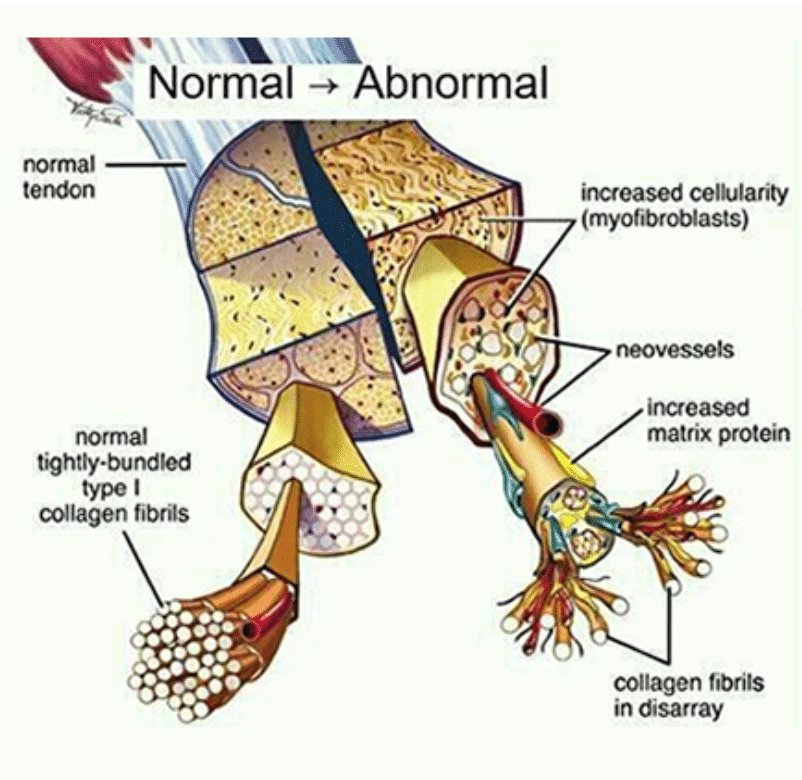Laurie's Blogs.
May 2021
A New Tendinopathy Protocol - maybe… maybe not…

This past week I was alerted to a summary of a research paper on management of tendinopathy lesions by my friend and colleague Amie Lamoreaux Hesbach. We then had a short exchange of thoughts… and I figured that the thoughts generated would make for a good blog. So here it is!
Reference
Breda SJ, Oei EHG, Zwerver J, et al. Effectiveness of progressive tendon-loading exercise therapy in patients with patellar tendinopathy: a randomised clinical trial. British Journal of Sports Medicine. 2021;55:501-509. https://bjsm.bmj.com/content/55/9/501.info (full text)
The summary can be found at the following link:
So, let me summarize the summary even further!
It was a group of 76 randomly assigned soccer players with ultrasound-confirmed patellar tendinopathy.
The either received 1) progressive tendon loading exercise (PTLE) or 2) eccentric exercise therapy (EET).
They were monitored for 24 weeks and assessed at the end via a questionnaire (Victorian Institute of Sports Assessment for patellar tendons (VISA-P) questionnaire), return to sport rate, patient satisfaction, and evaluation of exercise adherence.
The PTLE programme contained four stages. Patients in the intervention group performed either daily isometric (static), isotonic (dynamic), energy-storage (explosive) or sport-specific exercises depending on their treatment stage. Progressive load was administered based on the individual pain response (the Visual Analogue Scale score needed to be ≤3 points).
The control group performed eccentric squatting exercises, using a decline board, for twelve weeks.
What happened?
The Progressive loading group scored better on the VISA-P questionnaire. So right off the bat, you want to say, “well then, let’s do that!” However, the other comments were that the greatest difference between the groups occurred in the latter half of the training program (i.e. in the energy storage / burst exercise stage). (We will give that some discussion here shortly).
There was also a trend towards a higher return to sports rate in the PTLE group (43% vs 27%) however the relative success of the programme should be tempered by the fact that less than half of the patients in each group were able to return to sport. There was no significant difference in other outcomes, including patient satisfaction and exercise adherence.
How should we critically evaluate this research to make the most of it from a clinical perspective?
1. If we go back in time to when the Eccentric protocols were described by Alfredson et al. in 1998, they were typically prescribed for 12 weeks. So, to me, to continue on with eccentrics-only for an additional 12 weeks without training any other components is lacking in common sense!!!
2. I remember a talk by Karin Gravare (tendinopathy researcher) back in 2007. Even back then, at the height of the eccentric movement, she was staying, the data is leaning towards the concept of ‘Load The Tendon’ in any way you can – eccentric, concentric, isometric… So, to prescribe at eccentrics-alone is, again, poor management.
3. Explosive exercises / Energy storing exercises / Burst exercises. Yes, Yes, Yes! These to me are so important and so often forgotten! We need to train for burst. (Short retrieves, keep-away games, jumping up onto a platform…).
4. Neither of these protocols are 100% perfect. However, I think that combining them would likely give superior results! Train all of it!
Okay, that’s my synopsis of the synopsis… and how my brain interprets this research and how I would use this information clinically! I hope it helps you too!
Have a great week!
Cheers! Laurie


